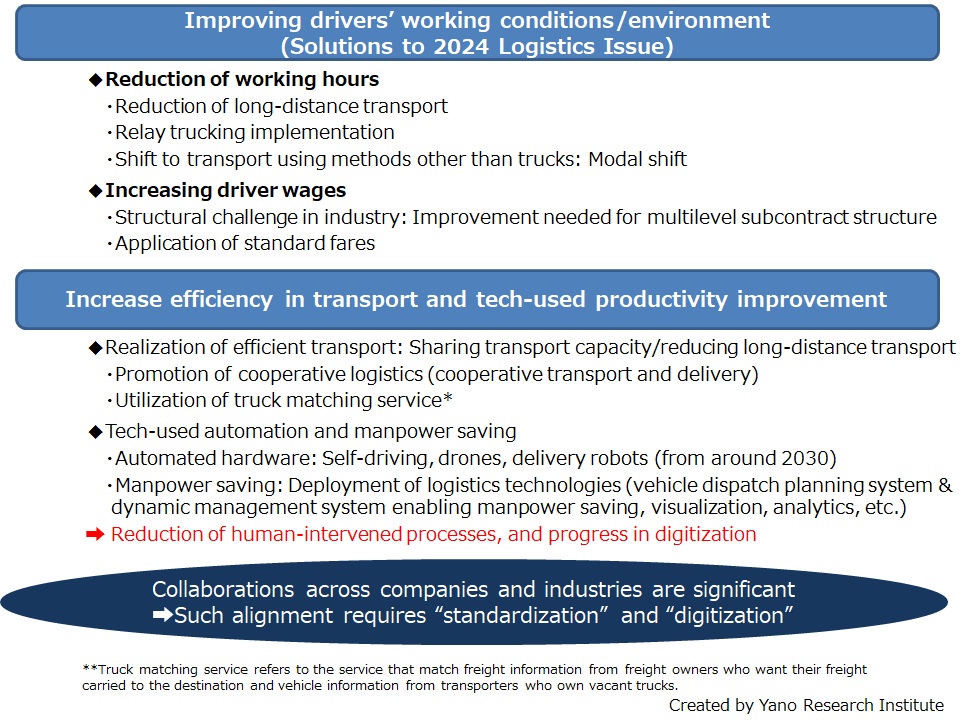No.3533
Improved Delivery/Transport Efficiency in Logistics in Japan: Key Research Findings 2024
Efforts to Improve Efficiency in Transport and Delivery Accelerated
Yano Research Institute (the President, Takashi Mizukoshi) has surveyed the domestic trends on freight transport and has compiled the efforts precedented in streamlining the transport and delivery and has given insights. Here discloses a part of the report.

Summary of Research Findings
Logistics in Japan currently faces an issue of acute labor shortage. As drivers’ overtime work caps started for transport or delivery (i.e., the 2024 logistics issue), sluggish logistics has been concerned for the future caused by undercapacity of transport. Here suggests two specific solutions to build sustainable logistics.
[Improvement in working conditions/environment for drivers]
There have been some efforts made to improve drivers’ long-working hours by introducing relay trucking that allows a day trip for a driver who drives with freight to the relay point and drives back to where he started with some other freight. Other efforts such as reduction of waiting hours before delivery acceptance and/or freight handling procedures begin, and palletization, i.e., abolishing manual cargo handling, are also needed at the same time. In addition to them, reviewing of contracted shipping fees between freight owners and transporters, and raising wages for drivers who carry and deliver freight are important.
[Increase in efficiency for transport & delivery and tech-used productivity]
Aiming to improve load efficiency as well as the rate of loaded distances, efforts such as cooperative logistics (cooperative transport and delivery) and use of truck matching services* have been in progress. Cooperative logistics enables sharing of logistics across different industries, which is expected to further increase efficiency in transport.
To achieve productivity improvement via technology, foreseeing full-scale deployment of automated hardware (self-driving, drones, delivery robots) in around 2030, development of technologies and legislation are underway. In software, introduction of vehicle dispatch planning and dynamic management systems are improving overall productivity as they digitize and save manpower.
*Truck matching service refers to the service that match freight information from freight owners who want their freight carried to the destination and vehicle information from transporters who own vacant trucks.
Noteworthy Topics
Relay Trucking Market Outline
Relay trucking is a model for transport that takes long hours or long distances, where drivers are exchanged at relay points that are set enroute, after covering certain distances for the freight transport. At the relay point, each of drivers can go back to where they started with their new freight, rather than keep on going for faraway destinations. There are three representative types of relay trucking, which are the type to exchange truck/tractor heads, the type to exchange freight, and the type to exchange drivers. It attracts attention as one of the solutions to suppress long-hour working by truckdrivers while eliminating labor shortages.
Major prerequisites for relay trucking are: 1) Relay points should be at the halfway of the whole distance for a driver to drive a day (at around 250km from the starting point, as the distance a driver can drive a day is set at about 500km), 2) relay points need to have a large space for a multiple number of large container trucks to park, 3) both the origin destination and the destination secure freight volume in bulk on a regular basis.
Relay trucking has started in around 2016 for the purpose to improve working conditions for long-distance drivers. Since FY2022, some demonstrations intended for actual implementations have begun, and companies having conducted some demonstrations have moved on to regular operations and have organized the bases.
On the other hand, however, relay trucking has some challenges such as high costs, difficulty in operation and management, and adjustment of freight volume.
Especially, high costs are the main obstacle that has prevented from reaching implementation in some cases despite after some considerations and demonstrations. Relay trucking is considered as necessary from the standpoint of solving long working hours by truckdrivers and labor shortages. It is required to make decisions to implement efficient relay trucking from the medium to long term perspectives rather than to compare costs in the short-term view.
Research Outline
2.Research Object: Businesses related to logistics in Japan (transport businesses, shipper companies such as manufacturers/wholesalers, logistics tech companies, etc.)
3.Research Methogology: Face-to-face interviews (including online) by expert researchers and literature research
Transport and Delivery
This research targets both transport that deliver middle or large-size freight for relatively long distances and delivery that refers to shorter-distant, small packet deliveries.
<Products and Services in the Market>
Domestic transport, road transport between logistics centers or bases, local delivery, relay trucking, modal shift, cooperative logistics (cooperative delivery, cooperative transport), truck matching service, vehicle dispatch planning system, dynamic management system
Published Report
Contact Us
The copyright and all other rights pertaining to this report belong to Yano Research Institute.
Please contact our PR team when quoting the report contents for the purpose other than media coverage.
Depending on the purpose of using our report, we may ask you to present your sentences for confirmation beforehand.